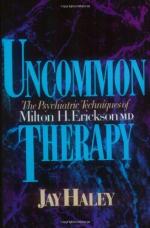
|
| Name: _________________________ | Period: ___________________ |
This test consists of 15 multiple choice questions and 5 short answer questions.
Multiple Choice Questions
1. Haley observes that there are repercussions throughout the family system (meaning people of the families that led up to this union are affected by the turn of events) when what occurs?
(a) The intersection of families.
(b) The arrival of offspring.
(c) The death of a grandparent.
(d) The death of a parent.
2. Haley writes in Chapter 8 that the most destructive parents are not those who treat their children badly but those who are what?
(a) Overprotective.
(b) Insensitive.
(c) Manipulative.
(d) Alcoholic.
3. Haley notes in Chapter 8 that people may or may not recognize that they need to be _______ their own children.
(a) Assisted by.
(b) Taught by.
(c) Left by.
(d) Weaned off.
4. The book ends with the wife of the man who had a stroke contacting Erickson after how long, with a request for a new set of therapeutic treatments?
(a) Six years.
(b) Two years.
(c) Twenty years.
(d) A decade.
5. Attendance at therapy permits Erickson to instruct the couple through an intervention how to enable them to do what?
(a) Understand their feelings.
(b) Understand each other.
(c) Make needed changes.
(d) Understand their past.
6. Erickson in the 20th century insists on addressing the _______ and asserts the right to include other individuals who are part of the trouble.
(a) Childhood difficulties.
(b) History of the patient.
(c) Actual problem.
(d) Patient's dream life.
7. Erickson relieves a severely injured old man of pain but further enables him to recover greatly from what in Chapter 9?
(a) Polio.
(b) A seizure.
(c) A stroke.
(d) A heart attack.
8. In Erickson's case in Chapter 6 which involved the boy's bed-wetting problem, Erickson suggested that if he didn't wet the bed for a month his parents were obligated to get him what?
(a) A bike.
(b) A new bed.
(c) A kitten.
(d) A puppy.
9. The therapist prescribes a specific course of action with the boy with behavioral problems in Chapter 6. With his direction and his assurance that her son is not being put in danger from doing so, the mother spends an entire day doing what?
(a) Spanking her son.
(b) Sitting on her son.
(c) Leaving her son in a locked closet.
(d) Yelling at her son.
10. The parents in Chapter 8 who had dependency issues revisited the therapist when their daughter became ______. They weren't sure how often they should visit.
(a) Estranged.
(b) A mother.
(c) A doctor.
(d) Paraplegic.
11. Chapter 7 includes examples of when one partner's ______ behavior has disturbed the sexual life of the couple.
(a) Creative.
(b) Coercive.
(c) Controlling.
(d) Abusive.
12. In the case where the husband has threatened to kill his wife unless she gives birth to a child of the gender he wants, Erickson recommends the couple do what?
(a) Don't have children.
(b) Divorce.
(c) Get an ultrasound.
(d) See a geneticist.
13. Erickson feels that when the circumstances of a patient need to be changed, it is wrong to prevent healthy growth by substituting ______ for good therapy.
(a) Friendly advice.
(b) Sedatives.
(c) Self-help books.
(d) Family treatment.
14. In one example in Chapter 8, a girl's _______ needed improvement, and she needed to lose a lot of weight.
(a) Family life.
(b) Body image.
(c) Social life.
(d) Sense of style.
15. Erickson gently refuses to help the man who had the stroke again in Chapter 9, claiming that even though it worked before, her husband is probably _____for his therapy to be effective.
(a) Too hurt.
(b) Too stubborn.
(c) Too old.
(d) Not willing.
Short Answer Questions
1. Haley states in Chapter 8 that great dramas are enacted when the dynamic between the parents has grown ______ in any way on their relationships with the offspring.
2. Erickson allowed previous patients to visit him of their own accord, on a _____ level.
3. Haley reports that power struggles about who is _____ in a marriage are quite normal during the early years.
4. Erickson believes that normally, the problem extends beyond the substance abuser and what is needed is actually a change of what?
5. Erickson accepted a client, a young woman who was living with her parents at an age when many other people's children had left home. She had been in a car accident and after recovering had undergone months of what?
|
This section contains 659 words (approx. 3 pages at 300 words per page) |

|




